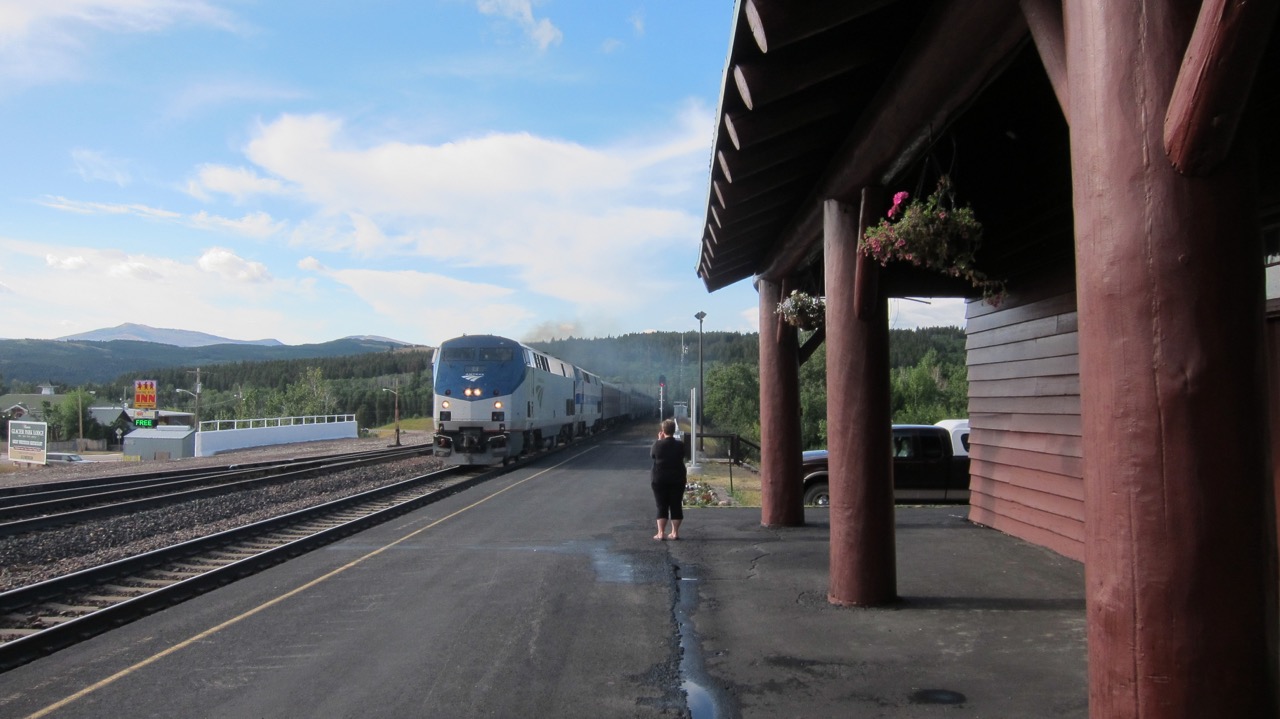From The West
Via Amtrak, the Empire Builder: See above. Also, you should note that the Empire Builder departs Portland and Seattle late in the afternoon, meaning that the trail will pass through most of the scenic Rocky Mountains in darkness, unfortunately.
Interstate 90: I think I-90 from Spokane to Missoula is the most underrated scenic drive in America. The road from Spokane to Coeur d'Alene offers views of desert, mountains and lakes but can be congested at times. East of Coeur d'Alene the traffic thins out and you drive thru the Silver Valley traversing Fourth of July and Lookout Passes at each end. The Silver Valley (Pinehurst to Mullan) was ground zero for a century long silver mining boom that ended a few decades ago. Now the valley has tilted toward tourism with the upgrading of the Silver Mountain Ski Resort, bike trails and mine tours. Try to stop in Wallace, in my opinion, the most beautiful small town in America.
Highway 2: See Kootenai Falls, the Cabinet Mountains and Libby Montana.
Highway 12: Again, less traveled and a longer drive but plenty of pretty mountain views.
From the South
Interstate 15: If you are coming up I-15 from Idaho or Utah, google maps will keep you on I-15 until just south of Butte, then it will direct you west on I-90. Instead, consider getting off I-15 at Anaconda and heading west then north on Montana 1. Montana 1 is a more intimate mountain drive that takes you past Philipsburg, one of the best preserved small mining towns in the West. The drive on Montana 1 really doesn't take any longer than I-90. At Drummond, you can head west on I-90 for a ways then north, or head east on E Front Street thru Drummond which turns into the East Frontage Road for a few miles then turn onto the Helmville Road/Highway 271. This eventually will lead you to Highway 141, then Highway 200, from which you can access Highway 83, described below.
Via Highway 93: Coming up from I-90 via highway 93 will take you through some low lying mountains up into the Flathead Valley. Around St. Ignatius, the National Bison Range (kind of a drive thru buffalo park) appears on the left, then the highway heads up thru the Flathead Reservation then up to Flathead Lake. Flathead lake, the largest freshwater lake in the U.S. west of the Mississippi, takes about an hour to drive around, so you'll get plenty of opportunities to view it. Taking Highway 93 west around the lake is quickest, with passing lanes in places and some nice pullouts to view the lake and valley. Taking Highway 35 around the east side of the lake is possible also. This route is slower as there is a lot of local tourist traffic and very rare chances to pass. Both routes around the lake are dotted with multiple opportunities to stop at state parks or local cherry orchards. (Cherries have been grown commercially along Flathead Lake since the 1930's, the climate moderating effects of Flathead Lake making cherry culture ideal).
Via Highway 200 and 83: This is a beautiful drive, starting out in the low mountains around the Clark Fork and Blackfoot Rivers, then heading Northwest along Salmon and Seeley Lakes. To the north of Highway 200 is the Bob Marshall Wilderness, together with the Great Bear Wilderness, is one of the largest roadless, wilderness areas in the lower 48. Salmon Lake in particular is a nice lunch stop. Traffic is not as heavy as via Highway 93.
From the North
Well, straight north of Moss Mountain is just wilderness. The North Fork Road ends at the Canadian Border and there is no legal crossing. To the Northeast the Canada Highway 6/Chief Mountain Highway MT 17 crossing is open typically May 15-Sept 30. Hours may vary but are typically 9 am - 10 pm peak season and 9 am - 6 pm early and late in the season.
To the Northwest, the nearest crossing is at Roosville/Eureka and is open 24/7 year round. Everyone knows about Banff and Jasper but to the west of Banff and Jasper are the lesser known but just as beautiful Glacier National Park (Canada) and Revelstoke National Parks. If you have time, work these parks in!
Below left: Heading north on Interstate 15, south of Dillon Montana
Below right: Flathead Lake at Flathead Lake State Park

